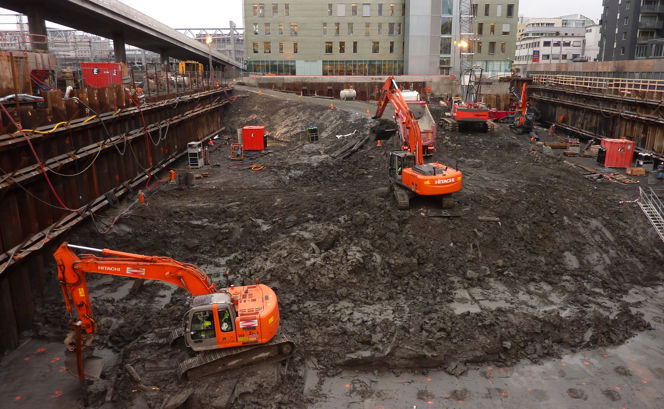Please note: The descriptions in sub-pages for this Project are presented only in Norwegian, please therefore click "Norsk" in the white, top menue line to see the Norwegian Project descriptions and links to reports etc..
The BegrensSkade project period was from 1 September 2012 until Autumn 2015 with 23 partners from the private and public sectors, who, together with the Research Council of Norway, support the project.
Ground work often results in unexpected and unwanted damage to neighbouring properties and adjacent infrastructure. Thus, there is significant potential in developing new methods and improved procedures to prevent or limit such damage within the building, construction and real estate sectors. Improved execution offers savings in terms of the amount of damage, more rapid implementation, less delay and fewer disputes.
The aim of "BegrensSkade" has been to develop new methods of implementation and improve interaction processes to limit damage that can be traced back to ground and foundation engineering work. The project has viewed the entire causal chain and improvement options from the design of ground works and foundation engineering to implementation and follow-up. The work has been carried out in multiple sub-Projects.
Background to the project
The aim of "BegrensSkade" has been to develop new methods of implementation and improve interaction processes for ground work, foundation engineering solutions and challenges faced by the building and construction sector with regard to ground conditions.
The background to the "BegrensSkade" research project is that too much unexpected and unwanted damage occurs to neighbouring properties as a consequence of foundation engineering work, particularly in connection with drilling for tie-back anchors and setting of steel core piles, but also other foundation engineering work.
Thus, there is significant potential in developing new methods and better procedures to limit and prevent such damage within the building, construction and real estate sectors. New developments on the project will help limit deformation and damage that can be traced back to foundation engineering work. Improved execution offers savings in terms of the amount of damage, more rapid implementation, less delay and fewer disputes.
The project will view the entire causal chain and improvement options. During project start-up, we will collect data and experiences from completed projects and assess the causes behind the damage. Following this, new methods and measures will be documented that will limit damage. Also, new tools will be developed for hazard, vulnerability and risk assessments in order to identify optimal solutions.
The aim of "BegrensSkade" has been to develop new methods of implementation and improve interaction processes to limit damage that could impact ground and foundation engineering work within the building, construction and real estate sectors. The project is widely supported by the Norwegian construction industry, with representatives from all players, (developers, contractors, sub-contractors, consultants, real estate and insurance companies, as well as research institutes and universities). The project has viewed the entire causal chain and improvement options from the design of ground works and foundation engineering to implementation and follow-up. "BegrensSkade" has been divided into six sub-projects:
- DP1+2 Identifying the causes of damage
- DP3 Further development of methods to limit damage
- DP4 Documentation of new methods
- DP5 Tools for risk assessment
- DP6 Improved interaction in the building and construction process

Plan for realisation
The project comprises the following main sections, spread over 3 years (September 2012 until 2015):
- Collect data and experiences from completed projects and create a list of typical causes of damage resulting from foundation engineering work or ground conditions
- Develop new methods and measures to limit damage
- Documentation of new measures and methods
- Development of tools for risk assessment (hazard, vulnerability and risk) and for identifying optimal solutions
- Improve interaction in the building and construction process
Overall goal
The overall goal of the project is to develop methods and processes that will help limit the extent of damage and unwanted settlements in connection with building, construction and real estate activity. The project partners have listed seven subsidiary goals that will result in the main goal.
- identify the causes of damage resulting from various types of foundation engineering work; explain why work sometimes proceeds surprisingly well under otherwise difficult conditions
- develop and document new methods and measures that can limit damage
- draw up guidelines (best practice) to prevent or limit future damage
- develop tools for risk assessment and choice of optimal solution
- improve interaction in the building and construction process, including interaction between clients, advisers, contractors and those carrying out the work
- increase skills on all levels regarding how building and construction activities impact the ground

